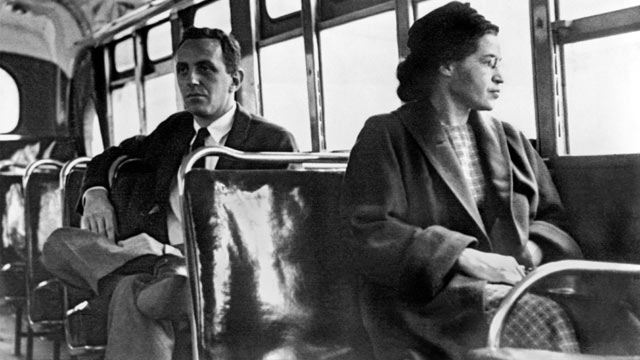This week marks the 50th anniversary of President Lyndon B. Johnson signing the Civil Rights Act, which made segregation unlawful and ushered stronger constitutional protections for people of color. There are still people who think that social justice and environmental issues are totally separate things, but as I’ve argued before, they’re not — and the Civil Rights Act is a case in point. The climate justice and environment worlds have benefited much from this law, particularly Title VI, which protects people of color from discrimination in any program or activity that receives federal funding.
While Title VI has been a somewhat suboptimal civil rights guardian in the environmental realm, it has had some successes in keeping people of color from suffering disproportionate pollution burdens — and in ensuring equal access to public transportation. Some of these successes were discussed this week in the webinar “Transportation Equity: A 21st Century Civil Rights Issue,” which was hosted by a coalition of civil rights groups called the Transportation Equity Caucus.
Three presenters each provided examples of how precisely transportation policy meets at the nexus of civil rights and environmental protection. After all, the original 20th century battles leading to the passage of the Civil Rights Act in 1964 were over rail and labor (check the Brotherhood of Sleeping Car Porters) and buses (check the Montgomery Bus Boycott). Civil rights advocates still rely on the law to address transit inequities, and not just in the post-Jim-Crow South.
The first example came from Dayton, Ohio. Beavercreek, a suburb east of Dayton, is one of the fastest growing job hubs in the state, anchored by a huge shopping mall. But when Dayton’s transit authority sought to extend bus routes from the predominantly African American neighborhoods of western Dayton into Beavercreek, the suburb’s council members balked, says Ellis Jacobs, an attorney with the group Advocates for Basic Legal Equality, Inc. (ABLE).
The council first created prohibitively expensive criteria for bus stop shelter construction, like saying they must come with heating and air-conditioning systems. The only other bus stops with such luxuries exist in Dubai, Jacobs said. When the impossible specs weren’t enough of a deterrent, the council voted unanimously not to allow the bus route to extend to the community. According to Jacobs, Beavercreek residents, who are mostly white, sent their council members messages like, “Don’t let West Dayton extend into Beavercreek,” a racial dog whistle for Keep those black people out.
In response to the council’s rejection, Jacobs teamed with a faith-based, grassroots coalition called Leaders for Equality and Action in Dayton (LEAD), to file a Title VI complaint with the Federal Highway Administration. They argued that because Beavercreek had accepted millions of dollars in federal highway funds to make it the economic boomtown it is today, it should be held accountable to the Civil Rights Act.
The FHA investigated, found Beavercreek in violation of Title VI, and told the council to reconsider the transit authority’s application to extend the bus routes or lose its federal funding. Beavercreek accepted the new routes and buses began transporting black West Daytonians out to the suburb’s job centers in January.
So the Civil Rights Act still has some punch. Fortunately, it’s not the only law people of color can rely on for civil rights protections. In Wisconsin, Karyn Rotker of the ACLU used the National Environmental Policy Act, or NEPA, to win transportation equity.
The FHA and the state’s transportation department were collaborating on a $1.7 billion highway expansion project, widening the Milwaukee Zoo Interchange road system, which leads to an exploding job growth area. At the same time, the state was cutting back public transit funding.
The ACLU joined with the Milwaukee Inner-city Congregations Allied for Hope (yes, the civil liberties organization fought alongside churches, not against them) and the Black Health Coalition of Wisconsin, Inc. The coalition argued that the government agencies behind the highway project had “failed to adequately consider the project’s effects on air quality,” and “failed to adequately consider cumulative social and economic impacts associated with expanding highway capacity.” A U.S. District Court judge agreed. The result was a $11.5 million settlement for added bus routes from black neighborhoods to the suburban job centers across the highway exchange.
These are victories scored this year, in 2014, not 1964. Recent celebrations — whether of the Civil Rights Act’s 50th, Brown vs. Board of Education’s 60th, environmental justice Executive Order #12898’s 20th — have tended to focus on triumphs of the past. But whether it’s the Baltimore kids helping back down a proposed trash incinerator or the Southern Coalition for Social Justice restoring public transit access for black communities in Greenville, S.C., there are still reasons to honor environmental civil rights today.
That legacy was on display last week in Jackson, Miss., where social justice groups of many stripes converged to celebrate the 50th anniversary of Freedom Summer. That was the courageous campaign carried out by black and white youth to get African Americans registered to vote under hostile Jim Crow laws. There, during an assembly titled “Climate Change and Environmental Justice: How Did We Get Here?,” attendees got an earful from Turkey Creek historian and activist Derrick Evans. He is the lead character featured in the documentary “Come Hell or High Water,” the story of how Mississippi attempted to erase the historically black Turkey Creek community to build shopping centers.
Addressing the Assembly, Evans explained how preserving Turkey Creek meant more than just upholding the Civil Rights Act, or any one law. Instead, the community had to converge a variety of civil society’s custodians — Sierra Club activists, Audubon Society bird watchers, Nature Conservancy conservationists, state wildlife biologists, faith leaders of black and white churches, civil rights lawyers, historic preservation officers — to protect it from reckless developers. This is where environmentalists found that they had more in common with social justice advocates, and vice versa, than initially recognized.
I’ll just let Evans take it from here:



